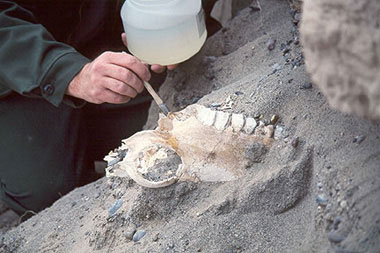
Camel

When someone mentions camels, what is the first image that comes to mind? For most people, its a dry hot desert with tall sand dunes. This is not unreasonable when we think of where the two types of modern camels live. The dromedary (single humped) is found in the Middle East (including the Sahara Desert) and the Bactrian (double humped) lives in the arid parts of Asia such as the Gobi Desert. Because of the close association of modern camels with the desert, most people are not too surprised when they find out we have fossil camels in southern Idaho. After all, with only 9 inches of precipitation a year this area is classified as a desert, so why shouldn't a camel be able to survive here. But the desert we see today didn't exist in southern Idaho 3 million years ago.
Camels originated in North American about 50 million years ago and their presence in the Old World is a recent event, geologically speaking. Most of their history is preserved in the fossil record in North America. Based on this record we know that most camels didn't live in deserts but were adapted to grasslands and parkland situations. Certainly the camels that we find in Hagerman Fossil Beds weren't living in a desert The presence of many other animals such as beaver, otter, muskrat, turtles, frogs and waterfowl indicate extensive wetlands in the Hagerman area 2 to 3 million years ago when camels roamed here. In fact, camels probably didn't adapt to desert conditions until after they dispersed into Asia and the Middle East.
Past evidence for camels and their close relatives, lames, at Hagerman has been scanty. The few bits and pieces, such as isolated teeth and toe bones didn't tell us much about these animals except that they were here. However, our knowledge of camels at Hagerman Fossil Beds took a giant step forward recently with the discovery of a complete skull of the extinct genus Camelops, whose name when translated, literally means camel face. Camelopsis known from a number of other places in Idaho, such as American Falls Reservoir. It is also known from many other localities in the western United States, including the well known La Brea Tar Pits in California. All of these other sites are from the younger Pleistocene epoch (known more popularly as the Ice Age). Our newly discovered skull is certainly a different species from the Ice Age Camelops. We are not yet sure which species of Camelopswe have, because specimens preserved from older rocks are few and far between. This complete skull from the Monument will greatly enhance our understanding of the early history of Camelops.
This skull is exciting for another important and totally unexpected reason. It came from a layer that wasn't supposed to have any bones in it! All previous discoveries of fossils in the Monument were made in the Glenns Ferry Formation, which is mostly composed of fine sands, silts and clays. Sitting on top of the Glenns Ferry Formation is a thick layer of coarse gravel known as the Tuana Gravels. Bones are rarely preserved in coarse gravels because the tumbling action of the gravel in fast moving water tends to break bone into small pieces. As it turns out, on top of the gravels is another layer of fine river channel sands, just right for preserving bone, and it was in this layer that the skull of Camelops was found. We don't know for sure the age of our new discovery but because of its position above the Glenns Ferry Formation we can be sure that it is younger than all the typical fossils found at the Monument. Perhaps it is as young as 2 million years or maybe younger. Although our skull of Camelops will provide much new information, more importantly it shows that even after 65 years of research, there is still much more to be learned about the Monument's fossils and geology.